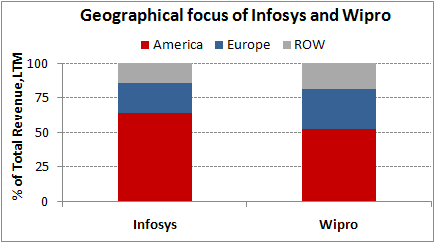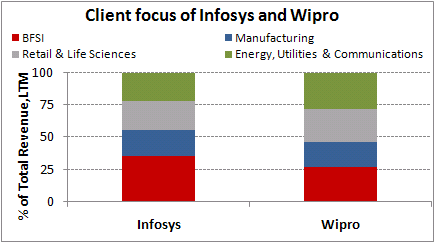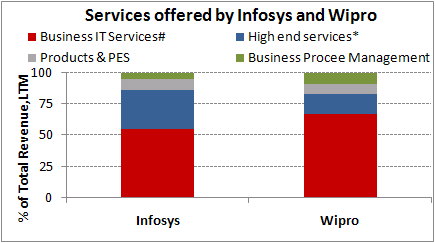- Home
- Outlook Arena
- Mar 21, 2012 - Infosys v/s Wipro: Which is better?
Infosys v/s Wipro: Which is better?
Information Technology (IT) sector has been one of the biggest growth drivers for the Indian economy, especially for the exports. As a proportion of India's Gross Domestic Product (GDP), the sector revenues have grown from 1.2% in FY98 to 6.4% in FY11. The sector has witnessed a spectacular growth in the last decade. The size of the India's information technology and outsourcing industries is expected to cross US$ 100 bn by FY12. And the sector continues to present a good opportunity in the future as well.
Naturally, companies in this sector have been on the investors' radar all the time. In fact, Indian IT majors such as Infosys, Tata Consultancy Services (TCS) and Wipro have become household names in the country. After all, they are among the biggest recruiters in India. All these companies are doing the same business. And it seems all they are same at the first glance. However, scratching the surface tells the different story. In the next few articles, we are going to compare Infosys and Wipro , the second and third largest companies in the Indian software sector.
At the onset, we would like to clarify two important points. First, the focus of these articles is to is to provide information so that the investors can decide for themselves as to which is a better company. Second, Wipro has diversified business interests, which include IT services (Including BPO business), IT products (hardware such as desktop computers, servers and notebooks), consumer care and lighting and Infrastructure engineering. On the other hand, Infosys is purely an IT services company. Therefore, for the sake of apple-to-apple comparison we would be referring only to Wipro's IT services business which contributes around 75% of the company's total revenues.
Let's get on with the key points of distinction between the two:
Geographical focus
Both the companies generate a large part of their revenues from the developed economies such as America and Europe. However, Infosys earns a larger chuck from the North American market. As compared to Infosys, Wipro has a higher share of revenues from the European markets. This makes Wipro more vulnerable to the prevailing uncertainty in the European markets. But the saving grace for the company is that it generates a large part of the ROW (Rest of the World) business from Indian and Middle East Markets, which have been growing in recent times.

|
|
LTM - Last 12 months ended December 2011 |
Industry wise client distribution
Banking, Financial Services & Insurance (BFSI) industry has been the biggest growth driver for the IT sector. And the same is true for Infosys as well. In fact, Infosys derives a large part of its revenues from this sector. Recently, Infosys has started focusing on the healthcare vertical which presents a good growth opportunity in the future. As for Wipro, all the industry verticals contribute almost evenly to total IT revenues.

|
|
|
Service focus
Here, Infosys seems to have some upper hand over Wipro as the former generates a larger share from the high end services such as consulting. A note to the readers is that these are also the higher margin businesses. Several IT services such as Application Development & Maintenance (ADM) are already commoditized. Hence, they do not offer better profitability. Considering this, Infosys had started focusing on high end services. And this helped company maintain its margins.

|
|
#ADM, Infrastructure Management, Testing etc, PES- Product Engineering Services |
Generally Indian IT companies are services oriented. Hence, they do not generate much from the product offering. However, since the advent of cloud computing companies have started focusing on Product, Platform & Solutions services. Infosys aims to grow this business to as high as 1/3rd of its total revenue. On similar lines, Wipro is also focusing on mobility, analytics and cloud computing. However, neither company can brag of a large contribution from cloud computing as of now as the offering is still at a relatively nascent stage.
So far, we have just talked about what these companies are and from where they earn their revenues. In the subsequent articles, we would compare their business strategies, financial performance and valuations of the companies.
Equitymaster requests your view! Post a comment on "Infosys v/s Wipro: Which is better?". Click here!
4 Responses to "Infosys v/s Wipro: Which is better?"
rajesh
Mar 31, 2012i think both of them are multi-locational, both are similar in many ways,
kusalovir
Mar 29, 2012Wipro may be said to be a better company on these two grounds, namely,- (1) Multi-product company producing mass-use products also in addition to being a IT company , and (2) Multi-locational company .
Pradeep Kumar Nair
Mar 22, 2012Products and PES are not the same thing and is too flattering for PES! The sooner Indian IT Services providers and analysts like you figure it out, better are the chances for companies to genuinely build products that global markets want


P
Jun 19, 2012The "High-end consulting services" for Infosys actually includes System Integration and Packaged Applications. Calling packaged applications 'high end' would not be appropriate. Neither is the margin profile of Packaged apps significantly different. The actual 'consulting' part that is really 'high-end' would not be more than 3%-5% is my guess. Margins are maintained but at the expense of volume growth, because no longer is a client willing to engage in 'higher price' deals with IT vendors.